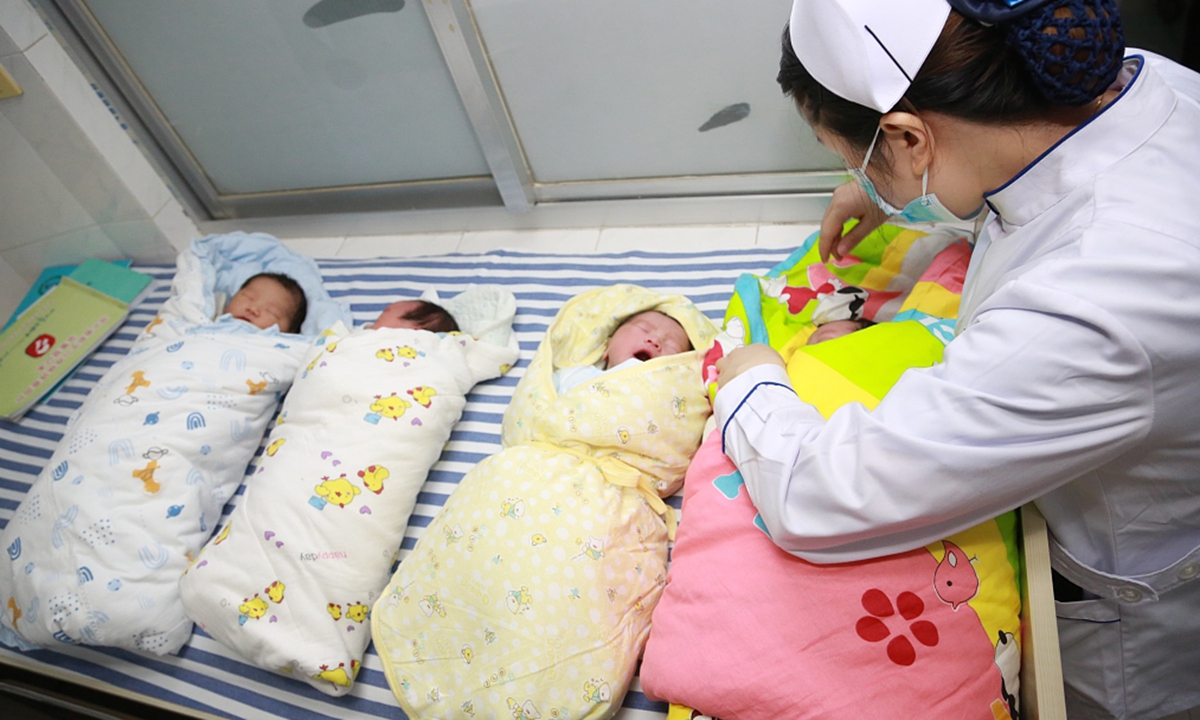
File Photo:VCG
Low fertility rate and negative resident population growth have recently been under the spotlight in China as the latest statistics show that 16 of the 34 provincial-level regions in the country have observed negative increase in their permanent population last year.
Experts warn that China must make early preparations for an unavoidable negative population growth and it will only be a matter of time before the trend expands further. Although little impact will be observed in the short term, it will weigh on China's labor force and the entire economy in the long run.
In an article published on WeChat by the China Population Association, Yuan Xin, professor of the School of Economics at Nankai University, said that China's negative population growth is unavoidable. A low fertility rate has been running in China for 30 years, and the inertia of positive population growth is about to be exhausted, Yuan explained, adding that the negative population growth will expand during the 14th Five-Year Plan (2021-2025).
"China will be the second major power in the world with negative population growth after Japan and the largest country with negative population growth. This trend will be an important aspect of the demographic situation China will need to face head-on in its future economic and social development decisions," Yuan said.
Negative population growth will have little impact on China's socioeconomic development in the short term, because the population will slowly decrease in the first few years by a few hundred thousand to a million or so a year, which is a very small percentage of China's 1.4 billion people, He Yafu, an independent demographer, told the Global Times on Tuesday.
However, in the long run, it will have a great impact on China's economy. Such trend, when coupled with an increasingly aging population, will weigh on the labor force and the pressure on pension payments will also be much greater. In addition, a prolonged negative population growth will weaken China's demographic advantages, and eventually drag down the country's economy.
The 2021 statistics showed that almost half of the provinces in China have experienced a negative growth in their permanent population, with the less-developed region of Northeast China seeing most declines as a result of population outflow and a low fertility rate. Meanwhile, the eastern and southern coastal provinces, which are more economically developed, attract large numbers of migrant workers from the central and western parts of the country, experts said.
Among the 16 provinces with negative population growth, the top six are Henan, Heilongjiang, Yunnan, Liaoning, Jilin and Hunan. Another 15 provinces recorded a positive population growth, with Guangdong, Zhejiang, Jiangsu, Fujian and Guangxi seeing the highest numbers of births.
"China's vast uneven population distribution and development gaps across regions have provided much room for population flow. The flow is precisely the advantage of a large population, which is conducive to achieve maximum benefit from the demographic dividend," Yuan noted.
However, he said that once the fertility rate and population size in most provinces show a decline, population migration will no longer be an effective way to deal with negative population growth, and it is only a matter of time before this trend evolves from limited areas to entire regions.
Yuan warned that population issues present themselves with a time lag, and once the problems have erupted, the best time to respond and manage is often missed.
To reduce the impact of negative population growth, maintaining an adequate level of fertility is the basis, but current policy incentives in China are far from enough, experts noted.
"The most direct way to increase the fertility rate is to introduce a childcare subsidy policy. Currently, only a few regions in China provide such subsidies and only until the child is 3 years old. Some provinces, although they have plans to introduce childcare subsidies, their implementation is always delayed," He told the Global Times, adding that childcare subsidy should be formulated at the central level and be paid until the child reaches the age of 6.
China passed an amendment to the law in August 2021, which allows each couple to have three children and stipulates support policies for childbearing in face of the urgency and gravity of China's population development beset by falling fertility rates, a shrinking workforce and an increasing aging population.
However, the third-child policy should not be limited to the removal of restrictions in childbearing, but more on the design and implementation of support measures, experts said.

